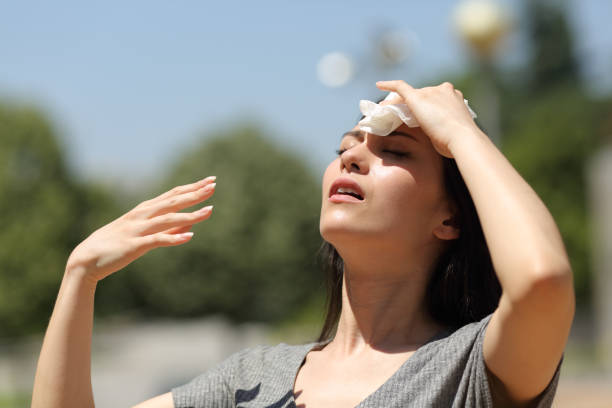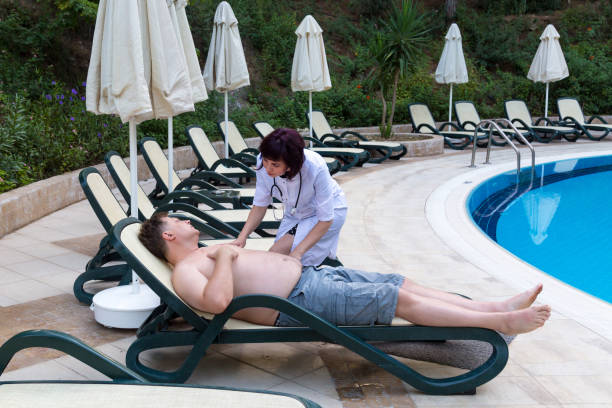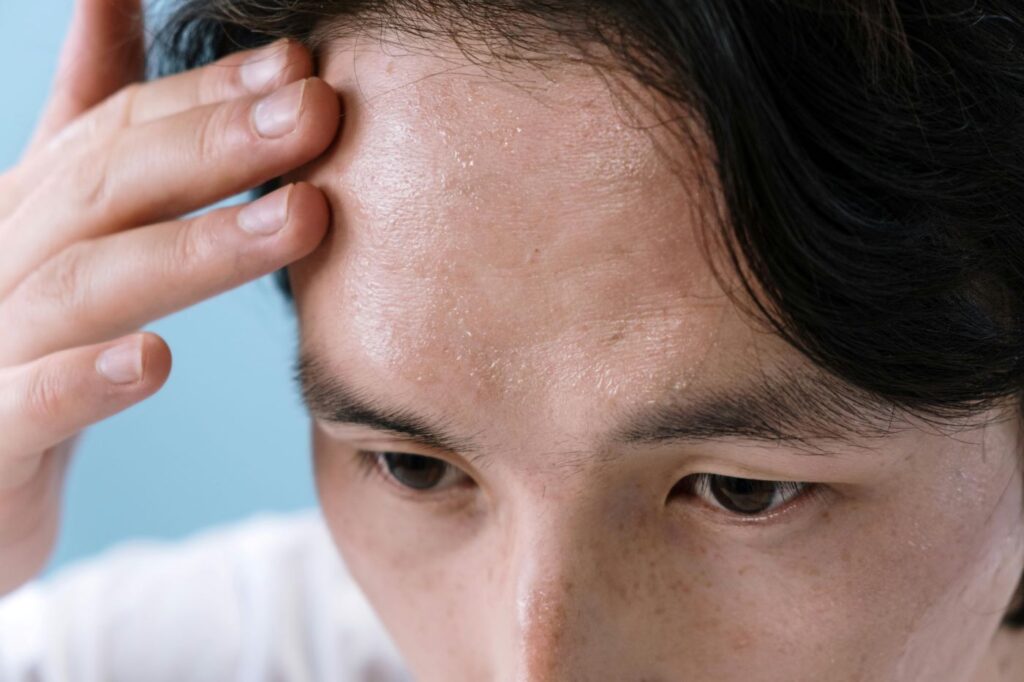Health Conditions
Know the Symptoms of Heat Stroke
Heat stroke is a dangerous condition that occurs when the body’s temperature regulating mechanism malfunctions.
This can occur for a variety of reasons, but the most prevalent one is prolonged exposure to extreme temperatures and humidity. When the body is unable to cool itself through sweating, the internal temperature quickly rises, resulting in heat stroke.
Heat stroke can also be triggered by physical activity in hot conditions, as the body produces more heat while exercising. Furthermore, some drugs and medical conditions can raise the risk of heat stroke. It is critical to be aware of these reasons and take preventive measures to avert this possibly fatal illness.
Heat stroke can affect everyone, although certain people are more vulnerable, such as those with chronic health disorders, elderly persons, and young children. Understanding the causes of heat stroke is the first step toward avoiding it and remaining safe in hot weather.

Common Symptoms of Heat Stroke
Recognizing the signs of heat stroke is critical for appropriate medical treatment. While the symptoms differ from person to person, there are a few typical ones to look out for. These include dizziness, confusion, headaches, a fast heartbeat, and hot, red, dry skin.
Dizziness and confusion might be early warning signs that the body is struggling to regulate its temperature. Headaches are frequently caused by increased pressure within the skull as the body’s temperature rises. Rapid pulse is caused by the heart working harder to pump blood and cool the body. Finally, heated, red, and dry skin indicates that the body’s sweat glands are not functioning properly.
It is crucial to know that heat stroke can advance quickly and cause symptoms to worsen. As a result, if you or someone close to you is experiencing any of these symptoms, you must act immediately.
Differentiating Heat Stroke from Other Heat-Related Illnesses
Heat stroke is just one of several heat-related disorders, and it’s critical to distinguish it from others. Heat exhaustion, for example, has symptoms similar to heat stroke, such as disorientation and rapid heartbeat. Heat exhaustion, on the other hand, is usually mild and can be treated with rest and hydration.
Heat cramps are another type of heat-related sickness that causes muscle spasms due to dehydration and electrolyte imbalance. Heat cramps can be uncomfortable, although they are less serious than heat stroke.
Differentiating between these disorders is critical for effective treatment. If you suspect heat stroke, get medical attention right once, as this disease requires emergency treatment.

Risk Factors for Heat Stroke
Certain factors can increase the likelihood of suffering a heat stroke. Understanding these risk factors is critical for implementing effective prevention measures.
One of the most significant risk factors is prolonged exposure to high heat and humidity without appropriate fluids or breaks. Vigorous physical exertion in hot conditions may also enhance the risk. Furthermore, certain drugs, such as those that reduce the body’s ability to sweat, can render people more vulnerable to heat stroke.
Certain medical disorders, such as heart disease, obesity, and diabetes, can all raise the risk of heat stroke. Individuals with these conditions should take particular measures when exposed to hot weather.
Recognizing the risk factors for heat stroke is critical for taking preventative measures and protecting oneself during hot weather.
Prevention Tips to Avoid Heat Stroke
Heat stroke can be avoided with proper precautions. Individuals can lower their chances of having this dangerous ailment by following preventative actions. Here are some strategies to prevent heat stroke:
- Stay hydrated: Drink plenty of fluids, even if you don’t feel thirsty. Water is the best choice, but sports drinks can also replenish electrolytes lost through sweating.
- Dress appropriately: Wear lightweight, loose-fitting, and light-colored clothing to help your body stay cool.
- Seek shade or air-conditioned environments: When the heat becomes intense, find shade or spend time indoors in air-conditioned spaces to give your body a break from the heat.
- Take breaks and rest: If you’re engaging in physical activity or spending time outdoors, take frequent breaks and rest in a cool area.
- Avoid alcohol and caffeine: These substances can increase dehydration and impair the body’s ability to regulate temperature.
- Use sunscreen: Protect your skin from sunburn, which can make it harder for your body to cool down.
By following these prevention tips, individuals can significantly reduce their risk of heat stroke and enjoy the summer months safely.

Treatment Options for Heat Stroke
If heat stroke does occur, immediate treatment is crucial to prevent complications. Here are some treatment options for heat stroke:
- Move to a cooler environment: If possible, move the person experiencing heat stroke to a shaded or air-conditioned area.
- Remove excess clothing: Help the person remove any unnecessary clothing to aid in cooling their body.
- Cool the body: Apply cool water to the skin or use ice packs on the neck, armpits, and groin area. This helps lower the body temperature.
- Hydrate: Offer cool water or sports drinks to rehydrate the person. Avoid giving them anything too cold, as it may cause shivering and raise body temperature.
- Seek medical attention: Heat stroke is a medical emergency, and it’s important to call for professional help immediately. Medical professionals can provide further treatment and monitor the person’s condition.
It’s critical to remember that heat stroke can have major health repercussions if not addressed right away. Taking the right steps during therapy can dramatically enhance the outcome and prevent complications.
Recognizing Heat Stroke in Children and Older Adults
Children and the elderly are more prone to heat stroke. It is critical to be aware of the indications and symptoms unique to various age groups.
Symptoms in children may include irritability, excessive thirst, dry mouth, a lack of tears when weeping, and an abnormally high body temperature. It is critical to regularly supervise youngsters during hot weather and keep them hydrated and cool.
Older persons may have difficulty controlling their body temperature, leaving them more vulnerable to heat stroke. Symptoms in older persons may include confusion, agitation, a lack of sweating despite the heat, and a body temperature above 104°F (40°C). Caregivers and family members should keep an eye on older individuals during hot weather and assist them stay cool and hydrated.
Recognizing these susceptible populations’ individual symptoms is critical to maintaining their safety and well-being during periods of excessive heat.

When to Seek Medical Help for Heat Stroke
Heat stroke is a medical emergency, and it is critical to understand when to seek immediate medical attention. If you or someone around you is having heat stroke symptoms such as confusion, rapid heartbeat, and scorching, dry skin, seek expert help right away.
While waiting for medical assistance, perform the previously mentioned treatment actions, such as moving to a cooler area and applying cool water to the skin. Remember that heat stroke can proceed quickly, and timely medical attention is critical for a successful outcome.
Conclusion
Finally, heat stroke is a serious ailment that can be fatal if not detected and treated quickly. Understanding the causes, symptoms, and risk factors for heat stroke is critical for prevention and early treatment.
Individuals can dramatically lower their risk of heat stroke by staying hydrated, wearing appropriately, seeking shade or air-conditioned locations, and taking regular breaks during hot weather. It’s also critical to recognize the unique symptoms in youngsters and older individuals and take extra steps to keep them safe.
If heat stroke occurs, quick care is required. Moving to a cooler area, cooling the body, and obtaining medical assistance are all critical stages in treating this disease.
To enjoy the summer months while being safe, keep educated and take preventative actions. Individuals can enjoy the summer while reducing their risk of heat-related illnesses by following prevention guidelines and detecting heat stroke symptoms. Remember, staying cool and hydrated is essential for staying safe in hot weather.
Trusted Health, Wellness, and Medical advice for your well-being



